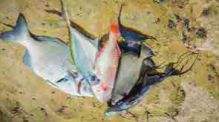Angola currently produces over 300,000 tons per year of fish and crustaceans, of which some 85% is consumed locally and aims to increase production by 30% in the coming years. One-third of Angola’s animal protein comes from fish and artisan fishing represents 30% of the country’s total fishing activity countrywide.
Despite a clear abundance of fish stocks, there is, as yet, no intense exploitation of the resource and few sizeable fishing vessels are in evidence. Nevertheless, such is the plenitude that Angolan’s fish and shellfish industry is already returning to its former pre-war prosperity.
Fisheries minister Victória de Barros Neto believes Angola has the potential to land much greater catches. The long coastline, normally blessed with hospitably calm seas, is clearly capable of greater sustained development and of providing food resources to meet the population’s demand for a healthier diet. Angola’s coast is 1,600 km long and its exclusive economic zone waters cover 330,000 sq. km.
As part of its effort to boost the fishing industry, Angola will hold its first ever International Fishing and Aquaculture Fair. FIP Angola (Feira Internacional das Pescas e da Aquaculture de Angola) runs from November 27-30. The event claims to promote the quality of fishery products, facilitate the exchange of experience and encourage innovation. Over 15 various countries have signed up to participate in this knowledge-sharing program.
Angola also has a well-developed tradition of sea angling as a sport along its extensive and uncrowded coast. The most accessible type of hobby-fishing involves beach-casting where not only record-sized fish can be captured, but provides a cost-efficient food source.
Game fishing from boats, is conducted by long-established clubs to distances as far as 50km offshore to hunt giant fighting fish such as blue marlins and tarpon.
Some of the largest Atlantic sailfish are caught off Luanda, and a record specimen of 64.6kg was landed off Lobito in March 2014. Angolan holds many of the world line records for sailfish and a Sailfish Classic game fish competition is held in Luanda every year with contestants taking part from around the globe.
Angola’s Ministry of Fisheries is making large investments in long-term structuring, spending $60 million on two fisheries protection and research vessels. These will help fight illegal fishing of protected species while also acting as rescue boats. In order to reinforce Angola’s capacity to control and inspect fisheries, the ministry also acquired scientific research vessel Pensador to study phytoplankton and zooplankton.
Another Ministry of Fisheries initiative announced in June involves using fish waste and fish with low commercial value in the production of animal feed supplements and fertilizer. The effort will also reduce the problem of environmental contamination.
The future looks increasingly bright for Angola’s diet as well as the fish and seafood resources that serve it. (From Sonangol Universo Magazine Sept 2014)



